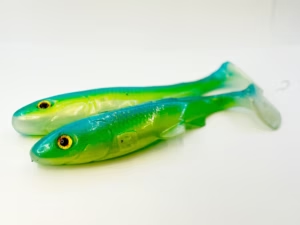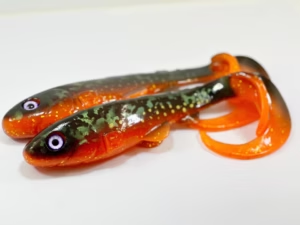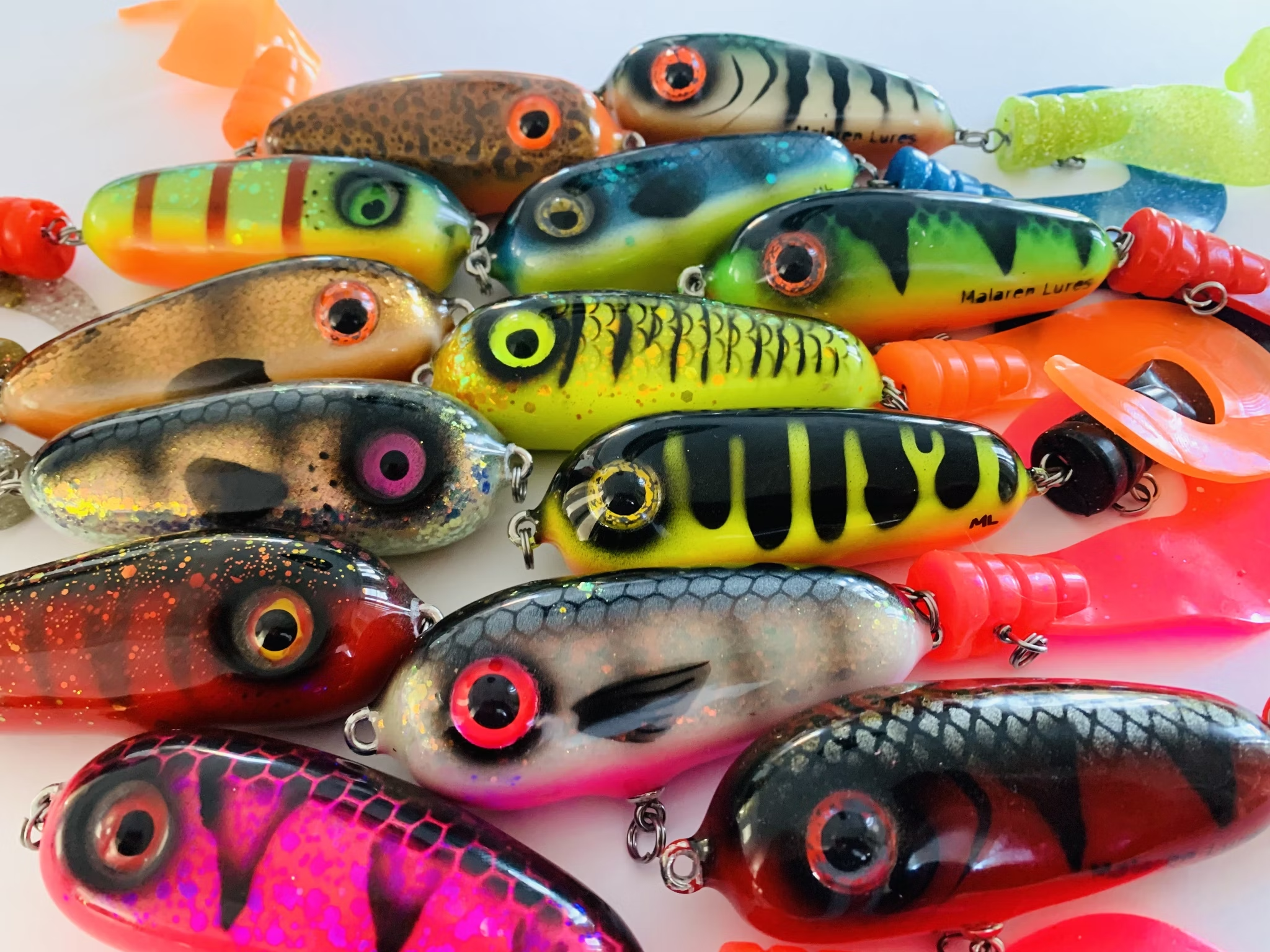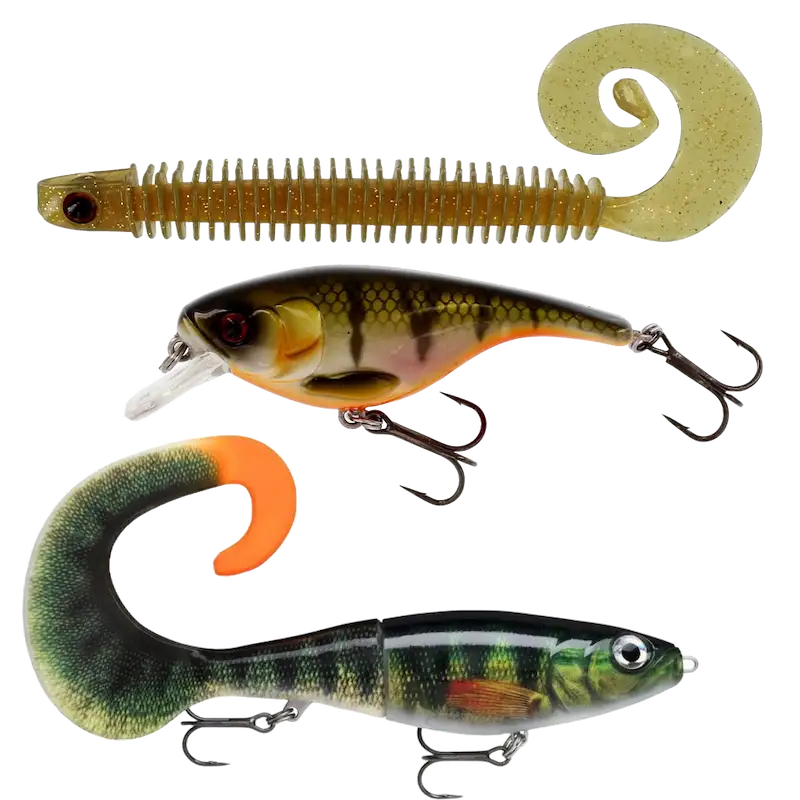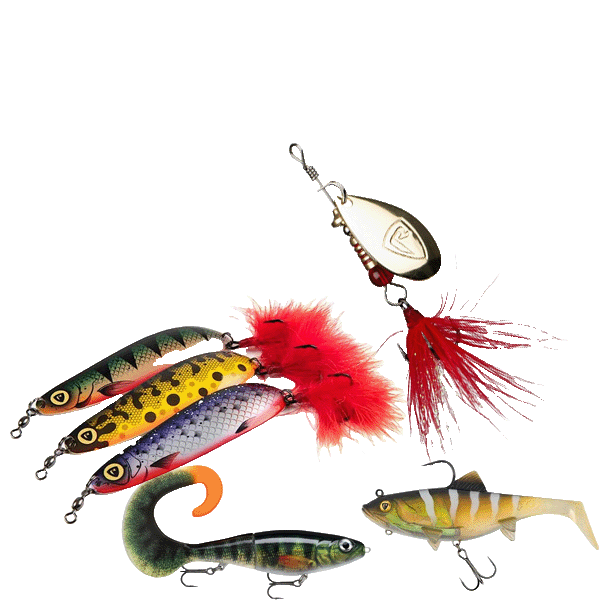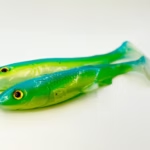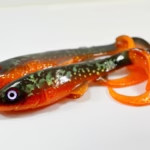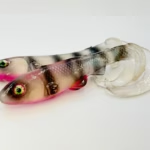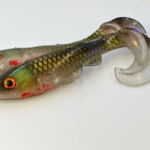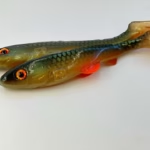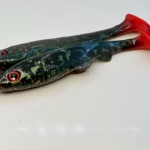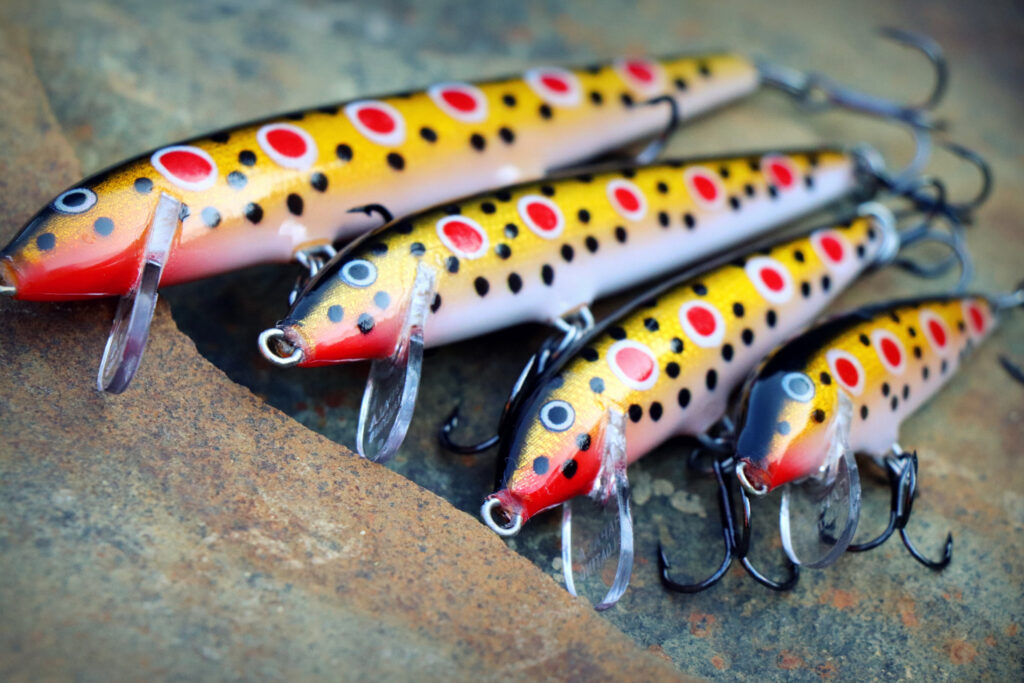
The Ultimate Guide to Handcrafted Balsa Lures and Lure Sets
Handcrafted balsa lures are functional works of art designed to tempt even the wariest fish. From tiny stream-dwellers to aggressive lake predators, there’s a balsa lure for every angling ambition. This guide digs into the complete range: the shapes, colours, set options, and the workings of each lure underwater.
Why Handcrafted Balsa Lures?
If you’ve ever held a wooden lure, you’ll know there’s nothing quite like it. Balsa has been the material of choice for generations of lure makers. It’s light, responsive, and floats with just the right subtlety. Anglers love it for its ability to mimic live bait, especially in tricky conditions.
Balsa wood’s unique cellular structure lets crafters carve and shape lures that twitch and glide convincingly. That’s a big reason many purists swear by balsa over plastic. The process is intensive: every lure starts as a rough blank, is carefully whittled, sanded, then fitted with weighted wire for balance. Paint is layered in natural patterns or bright fluos, and several coats of tough varnish seal the deal.
Handcrafted lures tend to come with fine detailing—gill plates, fin rays, subtle shifts in shading. None of this is for show. Those lifelike flourishes trick big, educated fish that have seen every artificial in the tackle shop.
The popularity of balsa lures surged in the 1950s, when Scandinavian and Eastern European makers proved their worth on record trout and salmon. These days, most balsa lures are tank-tested, meaning each one is checked for perfect balance before it goes in your box. The best can track straight in a current, wobble on the pause, or dart erratically—sometimes in the same retrieve.
Crafting balsa lures is an art that takes years to master. The best ones will fool even the most pressured wild fish. The only thing better than watching one get chewed is knowing it’s been carved and painted by hand, not stamped out by a robot.
Exploring Individual Lure Types
Minnows and Trout Patterns
The minnow shape is the backbone of most lure collections. Long, slim, and often just 35–100mm, these lures flash and wriggle in a way that’s deadly for trout, perch, and salmon. Choose from a palette of patterns: brown trout, brook trout, golden trout, rainbow trout, red tail, and pink tail. The lures are painted with painstaking detail—tiny parr marks, hints of iridescence, natural gradations from belly to back. This is to fool the most selective fish. On pressured streams the subtle authenticity of a handcrafted minnow can tip the scales in your favour.
Use smaller minnow lures in clear, shallow streams or when you’re targeting ultra-wary wild fish. In faster, deeper rivers or after a rain when the water is coloured, upsize to bigger models for greater visibility and impact. Some variants are built as jointed lures, adding a lifelike kick and movement that’s vital for provoking a reaction strike from suspicious predators. The extra articulation creates a broken, wounded baitfish motion that big trout and chub find hard to ignore.
Subtlety wins when the sun is high and the water is clear. Natural hues—the likes of olive, gold, silver—are deadly on bright days. But when clouds roll in, or the river turns murky after a storm, a bolder approach pays off. Switch to more vibrant or darker patterns to create a strong silhouette. The way you work the lure matters too. A slow, steady retrieve often fools fish holding in the main current, while a rapid, erratic jerk mimics a panicked minnow dashing for safety.
Using a jointed minnow increases strike rates during peak feeding windows, particularly when fish are pressured or following lures without committing.
Unique Colour Variants
Colour is a key detail that can transform your fortunes in seconds. While plenty of anglers are devoted to classic, natural shades, there’s a growing—and vocal—community that swears by high-visibility options. Fluorescent chartreuse, gold-and-purple yamame, orange king, and other colour-shifting paint jobs are all part of the arsenal. Fish don’t see colour quite as we do, so sometimes a seemingly outlandish splash of green, pink, or purple is exactly what it takes to flip a passive follower into an aggressive biter.
Go for high-vis and fluo lures in coloured water, at dawn or dusk, and during moments when fish are actively hunting. They’re also superb after heavy rain, when rivers run dirty. On clear and heavily pressured waters, more muted tones—like faded silver, soft olive, rich brown—will get you more follows and fewer refusals.
Lure colour can benefit catch rates especially under low-light or heavily stained conditions. Fluorescent patterns will outperform natural tones on overcast days in silty rivers, though they’ll be less effective on sunny days in clear water.
Don’t be afraid to experiment. Many veteran anglers will change lures a dozen times in an hour, searching for the exact hue that triggers bites. Browse through the spectrum of balsa lure colourways before deciding. Seasoned lure anglers often keep a selection of both natural and fluo finishes in their box, ready to react to changing light or mood.
Specialised Crankbaits and Jointed Lures
Crankbaits represent a whole different style of attack. They are designed to provoke reaction strikes rather than just imitate prey. The best balsa crankbaits are tight, compact, and feature a lively, wide wobble with a quick, buoyant rise when paused. These lures are built to dart over submerged obstacles like rocks and stumps, sending out tiny shockwaves that draw in predators from distance. Many rattle ever so slightly, while others rely on vibration alone. Deep-diving lips, or bills, allow them to reach those hard-to-fish pockets that often hold the biggest fish. You’ll find sizes ranging from nimble 35mm models up to 100mm cranks. Articulated or jointed versions are especially effective for species that prefer erratic movement.
Use crankbaits when searching for active fish or when you need to cover a lot of water. On lakes and reservoirs, a steady retrieve can be lethal, while in rivers, cranking down and allowing the current to swing the lure brings results. Attention to detail matters. If your lure isn’t tracking straight, if it’s rolling on its side, or if the wobble is too subtle or too wild, you may lose interest from the better fish. Take time to tune your lures if needed.
Jointed lures—sometimes referred to as ‘articulated minnows’—are the ace up your sleeve for slow days. Their extra movement mimics an injured baitfish or vulnerable fry. This unpredictability is irresistible to big trout, perch, and pike, who are always on the lookout for an easy meal. Switching to a jointed lure can increase your chances of landing a specimen fish after a weather front, when predators tend to be both cautious and opportunistic.
Niche Designs
Not every top-producing lure is a minnow or crankbait. Frogs, spawning fish patterns, and vairon (a classic European baitfish) add another layer of subtlety and surprise. Frog lures, usually about 35mm in size, are superb for fishing among weed beds or right along shallow margins where amphibians are a natural part of the menu. Cast them close to cover, and work them with short hops and pauses.
Spawning patterns, as well as vairon and juvenile designs, come into their own in rocky streams, clear pools, or sluggish backwaters—anywhere fish are dialled into specific prey. These patterns often feature bright ventral areas, ‘spawning blush’, or ghostly translucence to mimic vulnerable stages in a baitfish’s lifecycle.
Ultra-compact models also have a place, especially when facing tough, pressured waters where fish are easily spooked. These lures are small, subtle, and sometimes adorned with extra ‘ghost’ or ‘see-through’ effects that reduce their profile underwater. Hybrid concepts are gaining popularity too—some lures now combine a vivid head with a natural body, or attach a crankbait-style lip to a slender minnow frame. The goal is always the same: to present something just different enough to trip a reaction from fish that have seen it all.
The diversity in this range is enormous. No two waters are quite the same, and every angler will have their go-to models based on local conditions and target species. The trick is not just to pick a pattern that you like, but to learn what works in your river, lake, or stream at different times of year.
What Goes Into Lure Selection
Lure selection is grounded in observation, trial, and error. You’ll land far more fish when you take the time to consider not just the size, shape, and colour of your lures, but the way they interact with your target species, the local conditions, and your own fishing style. Adaptability is vital. One day, a drab silver minnow will be all the rage. The next, only a brash chartreuse crankbait gets you the results.
Start by thinking about the species you want to catch. For trout and perch, you’ll nearly always get best results with smaller minnows—subtle, natural, and under 60mm in length. These excel in clear streams, especially on bright days when fish are suspicious of anything too flashy. But don’t be afraid to go larger when you’re after salmon, pike, or chub, or when the water turns cloudy after rain. Big lures push more water, create more vibration, and draw attention in low visibility.
Colour makes a massive difference. Natural, muted shades—olive, brown, silver, gold—are most effective in clear water and when the sun’s shining. Fish become wary under these conditions, so subtlety is your ally. In contrast, when you’re faced with cloudy skies, stained rivers, or choppy water, it’s time to reach for brighter hues. Think vivid orange, fluo green, or deep purple. These colours cut through murk and give predators a strong outline to hone in on. Experienced anglers know that on some rivers, colour can be the difference between a blank and a red-letter session. Many anglers regularly switch colours at least five times per trip, chasing the right combination.
Match the hatch—use patterns that mimic whatever prey is most common in the water at that time, be it brown trout fry, sticklebacks, or tiny roach. Even the most realistic lure will fail if it looks out of place. Try to observe what’s swimming near the margins, or check the stomach contents of any fish you keep (where allowed). Sometimes, though, breaking the rules and using a totally contrasting pattern sparks aggressive territorial reactions—especially during spawning time or when food is scarce.
Action and behaviour count for as much as appearance. Some days, fish want a lure worked fast and hard—think frantic retrieves, sudden darts, or sharp pauses. This is often the case with aggressive summer trout or when targeting perch on the move. Other days, the only thing that works is a slow, lazy wobble or an almost motionless glide. Fine-tuning your retrieve can pay huge dividends. Simply changing your retrieve speed can lift your strike rate, particularly during cold snaps or just after a river has risen.
Water clarity is one of the most overlooked variables. Cold, murky water slows fish down and makes them more reliant on vibration and silhouette than colour. Jointed lures, deep divers, and cranks with built-in rattles are great here. In high summer, clear streams require ultra-realistic patterns and a gentle hand. There’s no substitute for observation—if you’re not catching, take a step back, check the clarity, and make a switch.
Temperature is a major player. In cold water, fish are sluggish and rarely chase fast-moving lures. Stick to slow retrieves and downsized patterns. During warm spells, fish perk up and are much more likely to smash fast, erratic presentations. The link between temperature and feeding activity is well documented: Most ectotherms (like trout and perch) show a metabolic rate increase of about 2–3× for every 10 °C rise in water temperature. Fish basically get more active as it warms within their ideal range.
If you want to cover your bases, most experts recommend carrying at least three or four distinct lure types in a variety of sizes and colours. Mix up slim minnows, chunky crankbaits, a jointed option, and maybe a wild card pattern. This rotation prevents the fish from growing wise to a single lure—a well-known problem on busy waters where many anglers fish the same patterns week in, week out.
Presentation is crucial, too. Consider changing not just the style but the depth at which you’re fishing. Use shallow runners early in the day or when fish are feeding high in the water column. Switch to deeper divers as the sun climbs or in response to changing river levels. Pay attention to where fish are holding and try to keep your lure in that strike zone as long as possible.
Don’t get stuck in a rut. If you’ve had no action after a dozen casts, make a change—whether it’s the size, colour, action, or depth. Moving from a minnow to a crankbait, or swapping to a jointed version, can be all it takes. Sometimes just a tweak, like switching from gold to silver or dropping down a size, triggers a strike from a hesitant fish.
It’s also worth mentioning the importance of tuning your lures. Check regularly that your lure swims straight and true. A bent eye or twisted split ring can ruin the action and cost you bites. It’s details like these that separate consistent anglers from the rest.
A final tip: keep a simple record of what works in different conditions. After a while, you’ll spot patterns—certain colours on cloudy days, jointed lures after rain, slow retrieves in spring. Use that knowledge to build a versatile, effective selection that’s right for you. Success isn’t luck. It’s about observation, adjustment, and using every tool at your disposal.
Curated Lure Sets for Versatile Angling
Lure sets give you a huge advantage in being adaptable and effective on the water. You can keep fishing confidently even as weather, water clarity, and fish mood change by the hour. A well-rounded tackle box for those new to fishing, and a time-saver for the experienced crowd, keeping you on the water instead of worrying about what’s missing.
A single set can make all the difference, whether you’re fishing unfamiliar waters or heading out for a multi-day trip. With so many fish species, habitats, and conditions to tackle, having an assortment at your fingertips puts you in control—never stuck with the wrong lure for the job. Those who bring a variety of patterns and styles catch way more fish than those relying on just one or two favourites.
Comprehensive Multi-Lure Sets
A thoughtfully chosen multi-lure set will typically offer five, eight, or sometimes even more balsa lures. The best sets include a range of sizes and shapes—long, slim minnows for shallow runs, deeper divers for plunge pools, jointed lures for extra action, and gliders for pressured waters. Within a single box, you’ll usually get both subtle natural finishes for those wary trout and showy, bright attractors for when you need to stand out in stained or fast water.
This mix means you can switch up your approach in an instant, swapping from a brown trout minnow to a chartreuse fluo crankbait as the light changes or a hatch comes off. In deeper rivers or big lakes, you might need a chunky deep diver to reach cruising predators. On fast, shallow riffles, a slim floating lure keeps you in the strike zone. With all these options available at once, you’re ready to make tactical decisions with every cast. Experienced anglers often keep detailed notes on what worked in different sets, building personal preferences over time.
Theme-Based Selections
Theme-based lure sets take things a step further by offering focused options for specific fishing challenges. Some sets are all about trout, offering a selection of classic prey patterns—think brown, rainbow, brook, golden, and vairon. These are perfect for rivers and streams with mixed trout populations, or when you want to “match the hatch” to perfection.
Other sets build around colour, providing a line-up of high-visibility lures for dirty or coloured water, dusk sessions, or overcast days. If you’re heading out after rain or targeting stocked waters, these bold finishes help you keep your lure visible and tempting. Switching to high-vis lures when nothing else is working can turn a quiet day into a successful one—especially in cloudy or turbulent water.
Promo or value sets are ideal for anglers looking to maximise their spend. They gather together the most proven, productive models into one affordable package, so you can experiment with different styles and patterns without breaking the bank. These are especially popular with beginners building their first kit or seasoned anglers wanting reliable standbys for their next trip.
Sets also make packing for travel simple. Instead of fussing over what to bring or leaving lures behind, you can grab a set and know you’re covered. No more rooting around for missing lures or fretting about whether you’ve chosen the right colour for a new venue. Just take the set, head to the bank, and get fishing.
Theme-based sets are handy for adapting to local “rules” too. If you know a river is dominated by golden trout or that vairon patterns excel in a local stream, a themed set puts the right lure in your hand, every time. It’s about matching your approach to what the fish are used to seeing—and sometimes, showing them something totally different to trigger curiosity strikes.
The Advantage of Pre-Selected Lure Assortments
The biggest draw of pre-selected lure assortments is the time and stress they save. If you’ve ever stared at a wall of lures in a tackle shop, you’ll know decision fatigue is real. Sets do the work for you, assembling a proven combination so you’re not guessing what to pack or buy.
For anyone fishing unfamiliar waters, variety is a lifesaver. Rivers and lakes are dynamic places. Water can change colour or level overnight. A pre-selected set gives you natural, high-vis, big, small, jointed, and classic options, so you’re prepared for any surprise. You’ll be more confident when you know your box is stocked for every scenario.
Another benefit is the way set composition mirrors what professional guides and competition anglers actually use. Years of experience filter down into each selection, making it a shortcut to “what works” without years of trial and error. If you’re building a kit for the first time, you get a ready-made foundation that takes you from small brooks to big reservoirs.
Many sets are built to include micro-lures for spooky, wild fish, alongside chunkier jointed minnows and crankbaits for when you’re after large chub or perch. If you’re a fan of experimentation, a themed set lets you try out new colours, shapes, or actions with zero risk—simply rotate through them and see what the fish respond to.
Sets are brilliant for group trips, families, or when you’re fishing with friends. Everyone can take a different lure and compare results. This often leads to friendly competition and plenty of learning about what works best, where. Some families split sets, so younger or less experienced anglers get to try lures they’d never have picked themselves.
There’s a social side too. Many clubs run “set only” competitions where everyone fishes from the same selection. This levels the playing field and puts the focus on skill, technique, and reading the water, not just who spent the most on fancy gear.
Over time, anglers develop favourites from their sets, building personal “go-to” lists for certain waters, seasons, or target species. But the real strength of a good set is flexibility—you’re always ready to adapt as conditions change.
Craftsmanship, Durability, and Performance
What really sets apart a good lure from a truly great one? Its craftsmanship.
When you pick up a hand-carved balsa lure, you’ll notice each one feels unique. No two will swim or look quite the same. This slight variation can work in your favour, especially if you’re fishing for species that have seen it all and have become cautious.
The difference begins with the materials. Quality balsa wood is the preferred choice for a reason. It’s lightweight and floats naturally. The right density helps the lure move in a way that mimics real prey. Before a lure even gets painted, it’s carefully cut, sanded, and shaped by hand. This process can take weeks. It’s not rushed.
Once the lure is shaped, the artistry continues. Makers use fine brushes to add detailed touches. You’ll see realistic gill plates, scale patterns, and subtle shifts in colour—details that help trick even the smartest fish. To protect this work, several coats of waterproof varnish are applied. This means your lure keeps its look, even after many trips to the water.
Durability matters, too. The best balsa lures are finished with strong, protective coatings. These layers help stop chipping, scratching, and fading from sunlight. Reliable split rings and sharp hooks are fitted to boost your chances when you get a bite. Some lures also use wire-through construction, where a strong wire runs right through the body. This design adds strength, making the lure better suited for larger fish or when you’re fishing rough spots.
How a lure performs in the water is what counts most. Each one is tank-tested before it reaches your tackle box. The maker checks its swimming action, how it floats, and how steady it is. If it doesn’t move just right, it doesn’t make the cut. This attention to detail is key for fishing in unpredictable rivers or weedy, snaggy stretches. Fish can spot when something isn’t quite right, so even a small flaw in how a lure swims can mean the difference between success and nothing at all.
Field testing is a crucial stage, and many lures are trialled by experienced anglers in real rivers and lakes. There are stories of hand-painted balsa lures surviving dozens of sessions in rocky streams, banging off stones and landing fish after fish, without any serious damage. While no lure is indestructible, these wooden gems outlast mass-produced plastic models by seasons. Eyes remain glued on, paint stays vibrant, and hooks maintain their edge. Should a hook or split ring ever fail, most repairs are straightforward—just swap out the hardware and keep fishing.
Maintenance is blissfully simple but crucial for extending the life of your favourite balsa lures. After each trip, rinse your lures thoroughly in fresh water—especially if you’ve been in brackish or dirty rivers. Allow them to dry completely before storing in a ventilated tackle tray or foam-lined box. This avoids swelling, flaking, or hardware corrosion. Sharpen hooks with a diamond file and check split rings periodically for wear. Most lures will reward you with season after season of solid performance if you give them even minimal care.
Many anglers develop a sentimental attachment to their most productive lures. There’s something special about a battered, hand-painted balsa minnow that’s landed its share of trout or perch. Experienced fishers almost always have a handful of “old faithfuls” that have been retired from active duty but are still tucked in the box for luck. It’s not uncommon to hear tales of a single lure out-fishing everything else for years, or landing multiple personal bests before finally succumbing to a lost snag or the teeth of a trophy fish.
So the true worth of a handcrafted balsa lure lies not just in its fish-catching prowess, but in its blend of artistry, durability, and long-term reliability. It’s a combination of factors—material, technique, hardware, and testing—that sets them apart. A lure that’s shaped and painted by hand carries a story, holds up to abuse, and performs exactly as promised, cast after cast. For many, that’s what keeps balsa lures at the top of tackle boxes everywhere.
Care, Storage, and Responsible Use
Balsa lures will serve you for years if you treat them well. Store them dry and separate, especially if you’re carrying several. Foam-lined boxes or magnet trays work best.
After every session, rinse your lures in clean water—especially if you’ve been fishing brackish or muddy rivers. Dry them thoroughly before stowing away. This helps prevent wood swelling, paint peeling, or rusting hardware.
Sharpen or swap hooks as needed, and check split rings for wear. A quick touch-up keeps everything fishing-ready. Don’t forget: barbless hooks make catch-and-release easier and reduce fish injury.
Use artificial lures responsibly. Avoid leaving them in the water or discarding broken models. Balsa is biodegradable, but split rings and hooks are not. Respect fishing limits and local regulations

